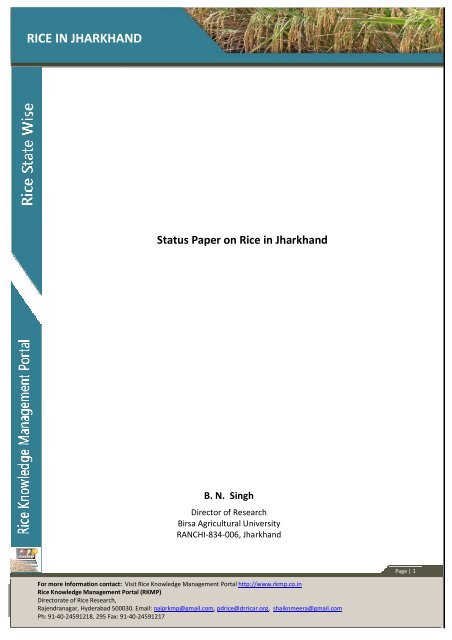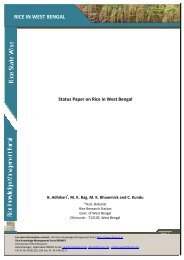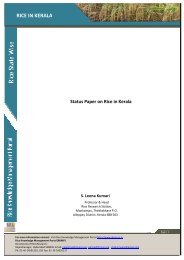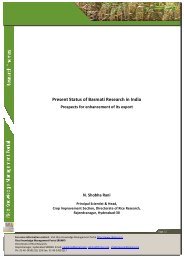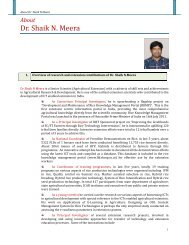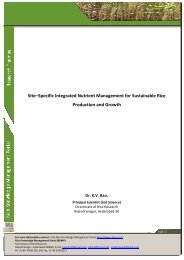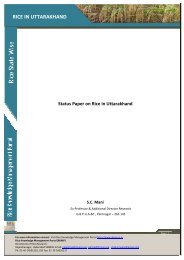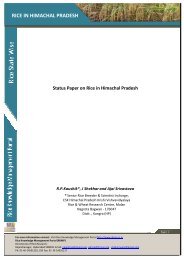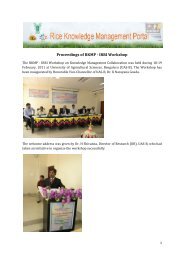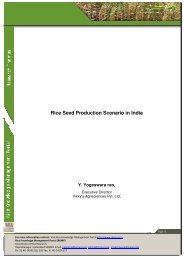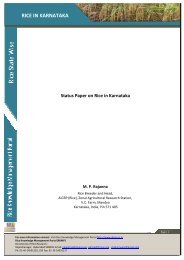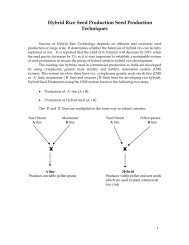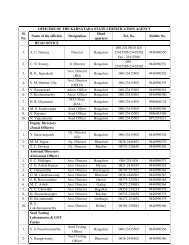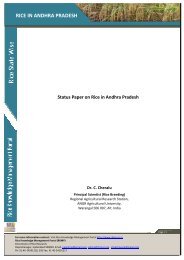RICE IN JHARKHAND - Rice Knowledge Management Portal
RICE IN JHARKHAND - Rice Knowledge Management Portal
RICE IN JHARKHAND - Rice Knowledge Management Portal
Create successful ePaper yourself
Turn your PDF publications into a flip-book with our unique Google optimized e-Paper software.
<strong>RICE</strong> <strong>IN</strong> <strong>JHARKHAND</strong><br />
Status Paper on <strong>Rice</strong> in Jharkhand<br />
B. N. Singh<br />
Director of Research<br />
Birsa Agricultural University<br />
RANCHI-834-006, Jharkhand<br />
Page | 1<br />
For more Information contact: Visit <strong>Rice</strong> <strong>Knowledge</strong> <strong>Management</strong> <strong>Portal</strong> http://www.rkmp.co.in<br />
<strong>Rice</strong> <strong>Knowledge</strong> <strong>Management</strong> <strong>Portal</strong> (RKMP)<br />
Directorate of <strong>Rice</strong> Research,<br />
Rajendranagar, Hyderabad 500030. Email: naiprkmp@gmail.com, pdrice@drricar.org, shaiknmeera@gmail.com<br />
Ph: 91-40-24591218, 295 Fax: 91-40-24591217
<strong>RICE</strong> <strong>IN</strong> <strong>JHARKHAND</strong><br />
Introduction about Jharkhand State<br />
Jharkhand which came into being on 15 November 2000 as the 28 th State of India with<br />
population of 26.91 million (2001 census) distributed in 24 districts is located between 22 0 - 25.5 0 N,<br />
latitude and 83.5 0 and 88 0 E longitude. The state has comprises forest tracks of Chhotanagpur<br />
plateau and Santhal Pargana and has distinct cultural traditions. The word Jharkhand, meaning<br />
"forest region," applies to a forested mountainous plateau region in eastern India, south of the Indo-<br />
Gangetic Plain and west of the Ganga's delta in Bangladesh. The tribal peoples, who are from two<br />
groups, Chotanagpurs and Santals, have been the main agitators for the movement.<br />
The state of Jharkhand has an area of 79,714 sq. km. and a population of 26.9 million. There<br />
are 24 districts, 211 blocks and 32620 villages. The State has population density of 338 per sq. km.<br />
(against national average of 312). The decadal growth rate of the state is NA (against 21.54% for the<br />
country) and population of the state continues to grow at a much faster rate than the national rate.<br />
The population of scheduled caste is about 3229131 while scheduled tribes 7077180 in the State<br />
(Table 1). The percentage of scheduled tribes to the total population of Jharkhand is 28.0% against<br />
the national level of 8.1%. Total fertility rate of the State is 3.2. The infant mortality rate is 46 and<br />
maternal mortality ratio is 312 which are higher than the national average. The sex ratio in the State<br />
is 941 as compared to 933 for the country.<br />
The Jharkhand State is comes under Agro-Climatic Zone VII (Eastern Plateau and Hill Region).<br />
The whole State is divided in 3 sub zones, viz. sub zone IV (Central and North-Eastern Plateau), sub<br />
zone V (Western Plateau Region) and sub zone VI (South Eastern Plateau). The sub zone IV consists<br />
of 12 districts i.e. Dumka, Jamtara, Deoghar, Godda, Sahebganj, Pakur, Hazaribagh, Koderma,<br />
Chatara, Giridih, Bokaro and Dhanbad, sub zones V has comes 9 districts i,e, Ranchi, Gumla,<br />
Simdega, Lohardaga, Palamau, Garhwa, Latehar, Khunti and Ramgarh while sub zones VI consists<br />
only 3 districts, West Singhbhum East Singhbhum and Saraikela districts. Jharkhand is primarily an<br />
agricultural state, and nearly 78% of population residing in 32620 villages depend mainly on<br />
agriculture and allied activities for their livelihood. There are three main crop seasons namely Kharif,<br />
Rabi and Summer. The food grains production is very low in the state and not meeting the<br />
For more Information contact: Visit <strong>Rice</strong> <strong>Knowledge</strong> <strong>Management</strong> <strong>Portal</strong> http://www.rkmp.co.in<br />
<strong>Rice</strong> <strong>Knowledge</strong> <strong>Management</strong> <strong>Portal</strong> (RKMP)<br />
Directorate of <strong>Rice</strong> Research,<br />
Rajendranagar, Hyderabad 500030. Email: naiprkmp@gmail.com, pdrice@drricar.org, shaiknmeera@gmail.com<br />
Ph: 91-40-24591218, 295 Fax: 91-40-24591217<br />
Page | 2
<strong>RICE</strong> <strong>IN</strong> <strong>JHARKHAND</strong><br />
requirement of the people of Jharkhand. Sustainable growth in agriculture sector is the “need of the<br />
hour” not only for the state but also for the country as a whole. A large area of about 14.8 lakh ha<br />
vacated by kharif rice is left fallow in rabi season in Jharkhand, which is typically called rice fallow.<br />
<strong>Rice</strong> is a major crop of the state during kharif with about 75-80% of net cultivated area under rice.<br />
The total population of the state is ~ 25 million and majority of the people are small and<br />
landless farmers living in rural areas. The state produces a little less than half of its food grains<br />
requirement. As a result, per capita food grain including pulses (13-14 gm per capita) availability has<br />
been 230 gm against 523 gm of all-India average and against 480 gm of minimum requirement.<br />
Additional annual production of 24-25 lakh tonnes will be an uphill task in a scenario where land<br />
holdings are small and continuously shrinking and the pressure on land keeps increasing. Rain-fed<br />
rice is the main crop covering 67.3% (1.48 m ha) in Jharkhand with a production of 10-14 q/ha (1.0-<br />
1.4t/ha). Further due to low yields of rice, farmers are always in debts, those results in migration to<br />
other places to sell their only resource labor. Moreover, malnutrition in women and children was<br />
reported to be high. Agro-climatically, the State is blessed with plenty of rainfall with varied soil<br />
types with dominance of medium and deep black soils and favorable thermal regime for year round<br />
cropping. The productivity of state is below the national average. As a result, the contribution of the<br />
state to the total food grain production of the country is unable to meet livelihood from agriculture a<br />
large number of small and marginal farmers from the state move to the urban areas.<br />
Jharkhand's mineral wealth also has been a problem for the tribes. The region is India's<br />
primary source of coal and iron. Bauxite, copper, limestone, asbestos, and graphite also are found<br />
there. Coal mining began in 1856, and tata iron and steel factory was established in Jamshedpur in<br />
1907. The socialist pattern of development pursued by the central government led to forced sales of<br />
tribal lands to the government, with the usual problem of perceived inadequate compensation. On<br />
the other hand, government authorities felt that because the soils of the region are poor,<br />
industrialization was particularly necessary for the local people, not just for the national good.<br />
However, industrial development brought about further influx of outsiders, and local people<br />
considered that they were not being hired in sufficient numbers.<br />
For more Information contact: Visit <strong>Rice</strong> <strong>Knowledge</strong> <strong>Management</strong> <strong>Portal</strong> http://www.rkmp.co.in<br />
<strong>Rice</strong> <strong>Knowledge</strong> <strong>Management</strong> <strong>Portal</strong> (RKMP)<br />
Directorate of <strong>Rice</strong> Research,<br />
Rajendranagar, Hyderabad 500030. Email: naiprkmp@gmail.com, pdrice@drricar.org, shaiknmeera@gmail.com<br />
Ph: 91-40-24591218, 295 Fax: 91-40-24591217<br />
Page | 3
<strong>RICE</strong> <strong>IN</strong> <strong>JHARKHAND</strong><br />
The Scheduled Castes population in India (Census, 2001) is 166,635,700 persons, constituting<br />
16.2% of the country’s total population. Being rural people, four fifth (79.8 %) of them live in rural<br />
areas and rest one-fifth (20.2 %) live in urban areas. The sex ratio of 936 females per thousand males<br />
is slightly higher than national average of 933 sex ratios. The highest percentage of SC population to<br />
the total SC population of the country live in U.P.(21.1%) followed by W.B.(11.1%) and Bihar (7.8 %),<br />
A.P.(7.4 %) and T.N.(7.1%). In fact, more than 57% of total SC population inhabit in these five States.<br />
Proportionately, the largest proportion of population of the SC to total population of the State is in<br />
Punjab (28.9 %), followed by H.P.(24.7%) and W.B.(23%). In A.P., Karnataka and Pondicherry<br />
proportion of SCs population is exactly equal to the National average of 16.2%. The smallest<br />
concentration of the SC population is in the North-Eastern tribal States such as Mizoram (with<br />
negligible or only 272 persons) followed by Meghalaya (0.5 %) and Arunachal Pradesh (0.6 %).<br />
The total population of the Scheduled Tribes in India (Census, 2001) is 84,326,240 persons,<br />
constituting 8.2% of the total population of the country. 91.7% of them lives in rural areas, whereas,<br />
only 8.3% inhabit in urban areas. The sex ratio of ST population at 978 females per thousand males is<br />
higher than the total population of the country as well as SC. M.P. accounts for the highest<br />
percentage of ST population to total STs population of the country (14.5%) followed by Maharashtra<br />
(10.2%), Orissa (9.7%), Gujarat (8.9%), Rajasthan (8.4%), Jharkhand (8.4%) and Chhattisgarh (7.8%).<br />
In fact, 68% of the country’s ST population lives in these seven States only. The proportion of the ST<br />
to the total population of the States/Union territories is highest in Mizoram (94.5%) and<br />
Lakshadweep (94.5%) followed by Nagaland (89.1%), Meghalaya (85.9%). Within the major states<br />
Chhattisgarh (31.8%) has the highest percentage of Scheduled Tribes population followed by<br />
Jharkhand (26.3%) and Orissa (22.1%). These proportions are in the lowest in Uttar Pradesh (0.1%),<br />
Bihar (0.9%), T.N.(1.0%) and Kerala (1.1%).<br />
For more Information contact: Visit <strong>Rice</strong> <strong>Knowledge</strong> <strong>Management</strong> <strong>Portal</strong> http://www.rkmp.co.in<br />
<strong>Rice</strong> <strong>Knowledge</strong> <strong>Management</strong> <strong>Portal</strong> (RKMP)<br />
Directorate of <strong>Rice</strong> Research,<br />
Rajendranagar, Hyderabad 500030. Email: naiprkmp@gmail.com, pdrice@drricar.org, shaiknmeera@gmail.com<br />
Ph: 91-40-24591218, 295 Fax: 91-40-24591217<br />
Page | 4
<strong>RICE</strong> <strong>IN</strong> <strong>JHARKHAND</strong><br />
Table1: General information of Jharkhand State<br />
Items Jharkhand India<br />
Total population (Census 2001) 26909428 1028832174<br />
Schedule Caste population (in million) 3.22 (12.0%) 166.64 (16.19%)<br />
Schedule Tribe population (in million) 7.08 (26.3%) 84.33 (8.19%)<br />
Rural populations 20908626 (77.7%) 742718043 (72.2%)<br />
Urban population 6000802 (22.3%) 28611413 (27.8%)<br />
Population below Poverty line (%) NA 26.10<br />
Pop. Density 274 324<br />
Literacy % 36.7% 64.8<br />
Female Literacy Rate (Census 2001) (%) 38.9 53.7<br />
Males 68.0% 75.3<br />
Crude Birth Rate (SRS 2008) 25.8 22.8<br />
Crude Death Rate (SRS 2008) 7.1 7.4<br />
Total Fertility Rate (SRS 2007) 3.2 2.7<br />
Infant Mortality Rate (SRS 2008) 46 53<br />
Maternal Mortality Ratio (SRS 2004-2006) 312 254<br />
Decadal Growth (Census 2001) (%) NA 21.54<br />
Sex Ratio (Census 2001) 941 933<br />
Source: Official website of Jharkhand Government (2001 Census)<br />
Jharkhand has 6 th<br />
largest population of tribals in the country and the recognition of<br />
Jharkhand is a result of the cultural specialty and diversity of the tribes. Tribes of Jharkhand are<br />
called the “Proto-austroloid” race. Most of the tribal languages are born from the “Austric” group.<br />
Only “Kurukh” language of the Oraon tribe and “Malto” language of the “Sauria Paharia” tribe are<br />
For more Information contact: Visit <strong>Rice</strong> <strong>Knowledge</strong> <strong>Management</strong> <strong>Portal</strong> http://www.rkmp.co.in<br />
<strong>Rice</strong> <strong>Knowledge</strong> <strong>Management</strong> <strong>Portal</strong> (RKMP)<br />
Directorate of <strong>Rice</strong> Research,<br />
Rajendranagar, Hyderabad 500030. Email: naiprkmp@gmail.com, pdrice@drricar.org, shaiknmeera@gmail.com<br />
Ph: 91-40-24591218, 295 Fax: 91-40-24591217<br />
Page | 5
<strong>RICE</strong> <strong>IN</strong> <strong>JHARKHAND</strong><br />
closer of the Dravidian group. All tribes of Jharkhand have their own religious rituals, social customs,<br />
conventions, family, clan, birth, death beliefs etc. Different tribals groups found in Jharkhand (Table<br />
2). ST and SC population in target districts (Ranchi, Dumka, Gumla & Palamau) is given in Table 3.<br />
Table 2: Different tribal group present and their population in Jharkhand<br />
SL Tribal Group Populati<br />
on<br />
Remarks<br />
1 Santhal 2060732 It is the first important tribe of Jharkhand. Santhal is close to ‘Austric'<br />
tribes. Mother tongue of the Santhal tribe is Santhali. There are 12<br />
clans in Santhals. They are Hansda, Murmu, Hembrom, Kisku, Marandi,<br />
Soren, Baske, Tudu, Pauria, Besra, Chode and Bedia. The most popular<br />
Gods of Santhals are called – Singbonga & Thakur.<br />
2 Oraon 1048064 It is the second important tribe of Jharkhand and it belongs to ‘Proto-<br />
Austroloid' tribe race. Mother tongue of the Oraon tribe is ‘Kurukh'.<br />
This tribe is divided into 14 different clans. They are – Lakra, Runda,<br />
Gari, Tirky, Kispotta, Toppo, Ekka, Linda, Minz, Kuzur, Bandi, Bek,<br />
Khalkho and Kerketta. Their important festivals are “Karma” and<br />
“Sarhul”.<br />
3 Munda 845887 It is the third largest tribe of Jharkhand. One is the religious mukhiya<br />
called “Pahan” and the other is the administrative mukhiya called<br />
“Munda”. Their main God is “Singbonga”. Their place of worship is<br />
called “Sarna” and place of panchayat is called “Aakhra”.<br />
4 Ho 536524 It is the 4 th largest important tribe and it is mainly found in Kolhan area<br />
of Singhbhum district. Manki Munda administration is the traditional<br />
tribal ruling system of the Ho tribe. They have mainly 6 sub castes viz.<br />
Suryavanshi, Daulatvanshi, Gonjhuvanshi, Kheri, Manjhiya, Bhogti.<br />
5 Kharwar 222758<br />
6 Bhumij 136110<br />
For more Information contact: Visit <strong>Rice</strong> <strong>Knowledge</strong> <strong>Management</strong> <strong>Portal</strong> http://www.rkmp.co.in<br />
<strong>Rice</strong> <strong>Knowledge</strong> <strong>Management</strong> <strong>Portal</strong> (RKMP)<br />
Directorate of <strong>Rice</strong> Research,<br />
Rajendranagar, Hyderabad 500030. Email: naiprkmp@gmail.com, pdrice@drricar.org, shaiknmeera@gmail.com<br />
Ph: 91-40-24591218, 295 Fax: 91-40-24591217<br />
Page | 6
<strong>RICE</strong> <strong>IN</strong> <strong>JHARKHAND</strong><br />
7 Khariya 141771 It is an “Aadim Kolariyan” tribe. This tribes is mainly divided into three<br />
branches – Pahari Khariya, Dudh Khariya and Dhelki Khariya.<br />
8 Lohara 169090<br />
9 chik Badaik 45645<br />
10 Souriya<br />
Pahariya<br />
61121<br />
11 Kora 21396 The Kora are very small tribe in Jharkhand. This tribe mainly resides in<br />
the Dumka district of the Santhal Paraganas. According to Risley, Kora,<br />
tribe is of Dravidian origin.<br />
12 Pahariya 13848 The parahiya are another small tribe and it resides in the Palamau,<br />
Latehar, Ranchi and Hazaribagh districts. Main occupation is to make<br />
baskets and beat drums.<br />
13 Kisan 28796 This tribe mainly resides in the forests of Ranchi and Palamau. This<br />
tribe is also called “Nagesia”. Their mother toungue is “Mundari”.<br />
14 Korwa 24027 This tribe mainly resides in the Latehar (Palamau Division). It is related<br />
to the Koleriyan tribe. This tribe has two sub castes (i) Pahari Korwa<br />
and (ii) Deeha/Dihariya Korwa.<br />
15 Banjara 432 Banjara are very Small tribe. This tribe is usually found in the Santhal<br />
Paraganas district.<br />
16 Kol 20432 It is related to “proto-Austroloid” group of the Kolariyan race. Their<br />
language is called “Kol Bhasa”. Kol tribes are divided into 12 clans.<br />
They are Hansda, Soren, Kisku, Marandi, Chaonde, Tudu, Hembrum,<br />
Baske, Besra, Chuniyar, Murmu and Kisnod. This tribe is the founder of<br />
the male dominated society. The Chief of the village is called Manjhi.<br />
17 Bediya 71719 This tribe resides mainly in Barkakhana area of the Hazaribagh district.<br />
The people of this tribe call themselves “Vedvani”.<br />
18 Mal Pahariya 60783 This tribe mainly resides in Dumka and Sahebganj area of the Santhal<br />
For more Information contact: Visit <strong>Rice</strong> <strong>Knowledge</strong> <strong>Management</strong> <strong>Portal</strong> http://www.rkmp.co.in<br />
<strong>Rice</strong> <strong>Knowledge</strong> <strong>Management</strong> <strong>Portal</strong> (RKMP)<br />
Directorate of <strong>Rice</strong> Research,<br />
Rajendranagar, Hyderabad 500030. Email: naiprkmp@gmail.com, pdrice@drricar.org, shaiknmeera@gmail.com<br />
Ph: 91-40-24591218, 295 Fax: 91-40-24591217<br />
Page | 7
<strong>RICE</strong> <strong>IN</strong> <strong>JHARKHAND</strong><br />
Paraganas. Their mother tongue is “Malto” which belongs to the<br />
Dravid family.<br />
19 Gond 44005 This tribe is a branch of “Dravid”. The people of this tribe reside mainly<br />
in Ranchi, Palamau and Singhbhum area. Gond have their own social<br />
organization named Mahasabha . The Gond society is ruled by the rule<br />
of exogamy intermarriage between clans, which are bhaiband or<br />
brothers to each other, is also prohibited. Monogamy and partilocal<br />
residence are general rule.<br />
20 Mahali 91868 This tribe resides mainly in Ranchi, Gumla, Lohardaga, Hajazribagh,<br />
Dhanbad districts. Their main God is “Suryadev”.<br />
21 Chero 60116 It is an important tribe of Munda / Kolariyan Adiwasi family. Main<br />
occupation is agriculture.<br />
22 Asur 9100 It is an important tribe of Singhbhum district and it belongs to proto-<br />
Austroloid race. They speak “Maley” or Asuri language of the munda<br />
class and Asur language. Sabar, Khond, Gorait, Birhor, Karmali, Birjiya,<br />
Baiga, Bathudi.<br />
Table 3: Tribal population in selected districts of Jharkhand<br />
Districts Percent ST Total Total ST Per cent ST Total SC Per cent SC<br />
population to state Population population population population population<br />
ST population<br />
Ranchi 10.7% 1779269 649637 36.5 % 101321 5.7 %<br />
Dumka 7.3 % 950853 443285 46.6 % 52763 5.5 %<br />
Palamau 1.7% 1182770 106254 9.0 % 324223 27.4 %<br />
Gumla 8.1% 707555 493563 69.8 % 25608 3.6 %<br />
Jharkhand 28.0% 35185358 6088772 27.6 % 2650611 7.5 %<br />
For more Information contact: Visit <strong>Rice</strong> <strong>Knowledge</strong> <strong>Management</strong> <strong>Portal</strong> http://www.rkmp.co.in<br />
<strong>Rice</strong> <strong>Knowledge</strong> <strong>Management</strong> <strong>Portal</strong> (RKMP)<br />
Directorate of <strong>Rice</strong> Research,<br />
Rajendranagar, Hyderabad 500030. Email: naiprkmp@gmail.com, pdrice@drricar.org, shaiknmeera@gmail.com<br />
Ph: 91-40-24591218, 295 Fax: 91-40-24591217<br />
Page | 8
<strong>RICE</strong> <strong>IN</strong> <strong>JHARKHAND</strong><br />
Status and Review<br />
3.1 Land Utilization Pattern<br />
The state having 24 districts and total geographical area is 79.71 lakh ha and an estimated 38 lakh ha<br />
is classified as cultivable. About 18 lakh hectare is the net sown area, comprising 22.7% of the total<br />
area and 47% of the cultivable area. The State has 9.9%, 7.2%, 3.48% and 15.22% of the total<br />
geographical area of the State as land put to non-agriculture use, barren & unutilized land, cultivable<br />
wasteland and current fallows, respectively (Table 4). The State has 23.33 lakh ha of land under<br />
forests, comprising 29.27% of the total geographical area, which is much above the national average<br />
of about 18%. The net irritated area is only 2.01 lakh hectare which is about 8% of the net sown area.<br />
The net sown area is less than half of all-India average (22.60% in Jharkhand while 46.10% in India).<br />
Percentage of net irrigated area in net sown area is only 10% against all-India average of 40.11%.<br />
About 90% of agricultural operations are depending on rainfall in this state. The average area of<br />
holding in Jharkhand is 1.58 ha and it was slightly higher than all-India average of 1.57 ha and the<br />
land surface is rugged and undulating, ranging from flat lands to almost steep slopes. The state<br />
produces a little less than half of its food grains requirement. As a result, per capita food grain<br />
availability has been 230g against 523g of all-India average and against 480g of minimum<br />
requirement. Additional annual production of 24-25 lakh tonnes will be an uphill task in a scenario<br />
where land holdings are small and continuously shrinking and pressure on land keeps increasing.<br />
Table 4: Land utilization pattern in Jharkhand<br />
S. No. Lands Area (Lakh/ha) Area (%)<br />
1 Forest land 23.33 29.27%<br />
2 Barren and uncultivated land 5.75 7.20 %<br />
3 Cultivable waste land 2.78 3.48 %<br />
4 Current fallow land 12.13 15.22 %<br />
5 Land put to non-agricultural use 7.90 9.90 %<br />
For more Information contact: Visit <strong>Rice</strong> <strong>Knowledge</strong> <strong>Management</strong> <strong>Portal</strong> http://www.rkmp.co.in<br />
<strong>Rice</strong> <strong>Knowledge</strong> <strong>Management</strong> <strong>Portal</strong> (RKMP)<br />
Directorate of <strong>Rice</strong> Research,<br />
Rajendranagar, Hyderabad 500030. Email: naiprkmp@gmail.com, pdrice@drricar.org, shaiknmeera@gmail.com<br />
Ph: 91-40-24591218, 295 Fax: 91-40-24591217<br />
Page | 9
<strong>RICE</strong> <strong>IN</strong> <strong>JHARKHAND</strong><br />
6 Land under misc. tree, crops and groves 1.10 1.38 %<br />
7 Net area sown 18.07 22.68 %<br />
8 Other fallow land 7.79 9.77 %<br />
9 Permanent pasture and other grazing land 0.86 1.10 %<br />
Total geographical area 79.71 100.00 %<br />
10 Arable Lands 26.70<br />
11 Gross cropped area 20.69<br />
12 Additional area to be brought under<br />
cultivation<br />
8.72<br />
13 Area sown more than once 2.61<br />
14 Area under double cropping 2.60<br />
15 Estimated acid soil (upland and medium land) 16.0<br />
16 Net Irrigated land ] 2.01<br />
17 Scope for extending double cropping area 6.30<br />
18 Soil Erosion moderate to severe taken 30.0<br />
3.2 SOIL <strong>IN</strong> <strong>JHARKHAND</strong><br />
The major area of the state covered with sandy loam to loam with acidic soils (pH 4.5–6.5) and<br />
having low fertility. About 66% area of soils are low in available phosphorous content, 18% soils low<br />
in K content, 38% soils low in S, 7% soils are deficient in available Zn, 4 % in available copper while 45<br />
% soils are deficient in available boron in the state. More than 70% of soils are deficit in organic<br />
carbon and micronutrients (Table 5). Majority of soils of the state have medium status of available<br />
nitrogen (280-560 kg/ha) and about 19.6% area have low available N content. About 49% area of<br />
soils are extremely acidic to strongly acidic (pH
<strong>RICE</strong> <strong>IN</strong> <strong>JHARKHAND</strong><br />
Lowland. The region has a large number of small and marginal farmers (
<strong>RICE</strong> <strong>IN</strong> <strong>JHARKHAND</strong><br />
Rajmahal area, micacious soil found in Koderma, Jhumeritilaiya, Barkagaon, and areas around the<br />
Mandar hill. Sandy soil are generally found in Hazaribagh and Dhanbad while black soil found in<br />
Rajmahal area and the laterite soil found in western part of Ranchi, Palamu, and parts of Santhal<br />
Parganas and Singhbhum. The water holding capacity of State soil is very low due to porous nature of<br />
the soil and undulating topography. Depending upon topography, soils are broadly classified into<br />
upland, medium land and lowland (Table 6).<br />
Upland: Upland soils are generally red, acidic (pH 5.5-5.9) and poor water holding capacity (WHC).<br />
Moisture is easily saturated during rains but release of moisture is very fast under upland. It is<br />
suitable for Kharif pulses (pigeon pea, urd, moong & kulthi).<br />
Medium land: Medium land soils is generally yellowish, slightly acidic (pH 6.0-6.5) and intermediate<br />
water holding capacity. It is suitable for Rabi pulses (chickpea, lentil & pea) and sequential cropping<br />
system, rice-chickpea/lentil, maize-chickpea/lentil may be taken. But in intercropping under irrigated<br />
situation, wheat + chickpea/mustard + chickpea/lentil can be taken<br />
Low land: This type of soils are grayish, slightly alkaline (pH 7.0-7.3) and high water holding capacity.<br />
Low land may be utilized for spring/summer. Low land is generally vacated after harvested of<br />
transplanted paddy in II nd week of December to II nd week of January and it takes time for removal of<br />
moisture. Farmers can be taken transplanted rice-spring/summer moong.<br />
Table 6: Land classes of Jharkhand State<br />
Group<br />
Sub<br />
Type<br />
Description<br />
group<br />
Don land Don I Low land Clay-loam soil, lowest in toposequence, suitable for long<br />
duration rice crop<br />
Don II Shallow land Clay loam soil and Best for rice production, Rarely faces<br />
drought, Suitable for medium duration rice<br />
For more Information contact: Visit <strong>Rice</strong> <strong>Knowledge</strong> <strong>Management</strong> <strong>Portal</strong> http://www.rkmp.co.in<br />
<strong>Rice</strong> <strong>Knowledge</strong> <strong>Management</strong> <strong>Portal</strong> (RKMP)<br />
Directorate of <strong>Rice</strong> Research,<br />
Rajendranagar, Hyderabad 500030. Email: naiprkmp@gmail.com, pdrice@drricar.org, shaiknmeera@gmail.com<br />
Ph: 91-40-24591218, 295 Fax: 91-40-24591217<br />
Page | 12
<strong>RICE</strong> <strong>IN</strong> <strong>JHARKHAND</strong><br />
Don III<br />
Drought prone<br />
shallow land<br />
Clay loam soil, transitional lands between don & tanr, upper<br />
toposequence and suitable for short duration rice<br />
Tanr land Tanr I Upland Loam soil and land immediately adjacent to the houses. Land<br />
used for vegetables, maize and rice seedlings<br />
Tanr II Upland Sandy loam soil, gentle sloppy, good soil depth, low WHC,<br />
poor in organic matter, erosion prone, acidic in nature<br />
Tanr III Upland Sandy loam soil, sloppy, poor soil fertility, shallow soil depth,<br />
low WHC, Near foothills and acidic in nature<br />
Operational holdings in Jharkhand<br />
Agricultural economy of the state can also be characterized by the existence of large number of small<br />
and marginal farmers. Agricultural operation in the state is of the sub-existence type due to the<br />
adverse land-man ratio. Land distribution pattern among the cultivators is highly iniquitous and a<br />
large number of holdings are said to be uneconomic. About 69 % operational holdings are 0.37<br />
hectare, occupying only 21.44% area. Only 0.69% operational holdings are below 10 hectare,<br />
covering over 9% area. Majority of the farmers thus come under the category of small and marginal<br />
farmers subsisting on a very small carning from farming operations. The average size of land holding<br />
in the State is 1.58 hectares. The share of land holdings of small and marginal farmers (having<br />
landholding of up to 2 hectares) to the total holdings in the State is 82.6% and that of large farmers<br />
(having land holding of more than 10 hectares) is only 0.7%. The medium farmers, with land holdings<br />
of 2 to 10 hectares, have the share of 16.7 % to the total land holdings. The land holding pattern of<br />
various categories of farmers is shown in Table 7.<br />
For more Information contact: Visit <strong>Rice</strong> <strong>Knowledge</strong> <strong>Management</strong> <strong>Portal</strong> http://www.rkmp.co.in<br />
<strong>Rice</strong> <strong>Knowledge</strong> <strong>Management</strong> <strong>Portal</strong> (RKMP)<br />
Directorate of <strong>Rice</strong> Research,<br />
Rajendranagar, Hyderabad 500030. Email: naiprkmp@gmail.com, pdrice@drricar.org, shaiknmeera@gmail.com<br />
Ph: 91-40-24591218, 295 Fax: 91-40-24591217<br />
Page | 13
<strong>RICE</strong> <strong>IN</strong> <strong>JHARKHAND</strong><br />
Table 7: Land Holding Pattern<br />
SL Level of farmers Average area (ha) Operational holding<br />
Number (lakhs) Percentage (%)<br />
1 Marginal (10.0 ha) 15.9 0.2 0.7<br />
Total 26.2 26.6 100.0<br />
The annual average rainfall in the state is about 1386 mm, which occurs mainly during in four<br />
months (June-Sept) Out of that, 80-85% received in 3½ months, from 15 th June to 30 th of Sept, 10-<br />
15% from Oct to Jan and very few rainfalls received in rest of the period (Table 8). Out of total rain,<br />
60% is used to be waste due to surface run-off and leaching. Therefore, only 40% rain remains left<br />
for crop use. As per estimate of average annual precipitation, about 20% water is lost by<br />
atmosphere, 50 % flow as surface runoff and balance 30% soaks into the ground as soil moisture and<br />
ground water. The state has immense potential of water harvesting and the suitable methods need<br />
to be perfected for application of stored water. To partially meet crop water requirement or in the<br />
rainfed project areas, rain water is to be conserved. It is done by enhancing infiltration of rainwater<br />
to fill up soil pores. Infiltration depends on soil texture at the surface, which cannot be changed.<br />
Hence, the land is configured to reduce runoff and give more time to rainwater and runoff to<br />
infiltrate.<br />
For more Information contact: Visit <strong>Rice</strong> <strong>Knowledge</strong> <strong>Management</strong> <strong>Portal</strong> http://www.rkmp.co.in<br />
<strong>Rice</strong> <strong>Knowledge</strong> <strong>Management</strong> <strong>Portal</strong> (RKMP)<br />
Directorate of <strong>Rice</strong> Research,<br />
Rajendranagar, Hyderabad 500030. Email: naiprkmp@gmail.com, pdrice@drricar.org, shaiknmeera@gmail.com<br />
Ph: 91-40-24591218, 295 Fax: 91-40-24591217<br />
Page | 14
<strong>RICE</strong> <strong>IN</strong> <strong>JHARKHAND</strong><br />
Table 8: Meteorological features of different Agro-Ecological Zones of Jharkhand<br />
Rainfall (mm) Zone IV Zone V Zone VI<br />
June-September 1098 (82.4%) 1174 (83.3%) 1053 (80.6%)<br />
October-November 90 (6.0%) 96 (6.7%) 69 (5.3%)<br />
December-February 54 (4.1%) 71 (5.0%) 58 (4.4%)<br />
March-May 88 (6.1%) 68 (4.8%) 122 (9.4%)<br />
Total rainfall 1330 1409 1302<br />
Temperature ( 0 C)<br />
Maximum 44.2 43.6 44.8<br />
Minimum 4.8 5.3 6.6<br />
Average 25.3 25.8 27.2<br />
Relative humidity (%)<br />
4.30 am 62.5 56.5 63.0<br />
5.30 pm 47.5 42.0 65.0<br />
3.4 Food grains production in Jharkhand:<br />
The food grains production is very low in the state and not meeting the requirement of the people.<br />
The sustainable growth in agriculture sector is the “need of the hour” not only for the state but also<br />
for the country as a whole. Food grain crops grow in Jharkhand on about 2.38 million ha area, which<br />
represents 1.92% in all India acreage. The food grains production has gone up from 2.07 to 3.69<br />
million tones, which represent from 1.59-1.70% in All-India average between 2005-06 and 2006-<br />
2007. The food grains production trend in Jharkhand is to be increased from 2.07 m tones to 3.69 m<br />
tones between 2005-06 to 2006-07) as compared with other neighbor states like U.P. (41.21mt),<br />
W.B.(15.97mt), Bihar (11.10mt), Orissa (7.34mt), Chhattisgarh (5.81mt) and All-India (217.28mt).<br />
For more Information contact: Visit <strong>Rice</strong> <strong>Knowledge</strong> <strong>Management</strong> <strong>Portal</strong> http://www.rkmp.co.in<br />
<strong>Rice</strong> <strong>Knowledge</strong> <strong>Management</strong> <strong>Portal</strong> (RKMP)<br />
Directorate of <strong>Rice</strong> Research,<br />
Rajendranagar, Hyderabad 500030. Email: naiprkmp@gmail.com, pdrice@drricar.org, shaiknmeera@gmail.com<br />
Ph: 91-40-24591218, 295 Fax: 91-40-24591217<br />
Page | 15
<strong>RICE</strong> <strong>IN</strong> <strong>JHARKHAND</strong><br />
3.5 Present position of different cereal crops in Jharkhand:<br />
About 91% of the cropped area is covered under food crops in Jharkhand including 84%<br />
under cereals and 7% only pulses. Cash crops constitute 3% followed by oil seeds, sugarcane and<br />
tobacco. The rest 6% of the cropped area is covered under vegetables and fruits. Among cereals,<br />
rice, maize, wheat, ragi is important. <strong>Rice</strong> is grown in three seasons in India, where Kharif season<br />
accounts for 88% production while Rabi covered only 12% production. <strong>Rice</strong> is the single most<br />
important food crop in India and occupies 44.0 m ha while Jharkhand contributes about 1.62 m ha<br />
under rice cultivation. During 2007-08, the area under rice is 16.44 lakh ha, production 33.26 lakh<br />
tones and yield 2023 kg/ha (Table 9). The yield of rice in Jharkhand is higher (1832 kg/ha) followed<br />
by W.B. (2593 kg/ha), U.P. (1879 kg/ha) and All-India average (2131 kg/ha).<br />
Maize is the 2 nd important crop of the state occupying 6% cropped area. The area of maize<br />
(2.40 lakh ha) in Jharkhand is higher than W.B. (0.90 lakh ha) followed by U.P. (8.7 lakh ha), Bihar (6.4<br />
m ha), and in India (78.9 lakh ha) during 2006-07. The current area under maize is around 2.37 lakh<br />
ha, production 3.56 lakh tones and yield 1500 kg/ha (Table 9). Maize does possess tremendous<br />
potential in diversified agriculture prospects in terms of feed for dairy, poultry, piggery and agroindustries.<br />
Wheat is 3 rd important crop of the state occupying nearly 3% of the cropped area under<br />
cereals crops in the Jharkhand. In the wake of the fast growing consumption demand of wheat in the<br />
state, some area of low yielding millets will have to be gradually replaced in the cropping system.<br />
The area under wheat is 86341 ha, 129511 tones production and yield 1500 kg/ha during 2007-08<br />
(Table 9).<br />
Coarse cereals are the 4 th important crops of the state, which occupying 2.45% cropped area<br />
under coarse cereals. The area of coarse cereals is 2.9 lakh ha in the state which is lower than<br />
neighbor states U.P (22.0 lakh ha), Bihar (6.9 lakh ha), Chhattisgarh (3.3 lakh ha), Orissa (1.6 lakh ha),<br />
W.B. (1.1 lakh ha), and in India (287.1 lakh ha) during 2006-07. The current area, production and<br />
productivity of marua, jowar and bajra are given in Table 9.<br />
For more Information contact: Visit <strong>Rice</strong> <strong>Knowledge</strong> <strong>Management</strong> <strong>Portal</strong> http://www.rkmp.co.in<br />
<strong>Rice</strong> <strong>Knowledge</strong> <strong>Management</strong> <strong>Portal</strong> (RKMP)<br />
Directorate of <strong>Rice</strong> Research,<br />
Rajendranagar, Hyderabad 500030. Email: naiprkmp@gmail.com, pdrice@drricar.org, shaiknmeera@gmail.com<br />
Ph: 91-40-24591218, 295 Fax: 91-40-24591217<br />
Page | 16
<strong>RICE</strong> <strong>IN</strong> <strong>JHARKHAND</strong><br />
Table 9: Trends of area, production and yield of cereals crops in Jharkhand<br />
Area – (000) hectare, Production – ‘000’ Metric tonnes, Productivity– Kg/ha<br />
Year Head <strong>Rice</strong> Maize Wheat Marua Jowar Bajra Total<br />
Area 1463.700 156.910 65.940 40.400 0.390 0.420 1686.550<br />
2000-01<br />
Productio<br />
n<br />
2278.600 247.170 108.480 25.200 0.230 0.260 2544.250<br />
Yield 1584 1575 1742 624 590 619 1508<br />
Area 1520.610 139.880 65.380 40.90 0.390 0.430 1725.870<br />
2001-02<br />
Productio<br />
n<br />
2732.580 209.190 115.360 25.200 0.230 0.40 3057.130<br />
Yield 1930 1495 1811 624 590 558 1771<br />
Area 1383.290 157.630 68.190 12.100 1.490 0.340 1622.980<br />
2002-03<br />
Productio<br />
n<br />
2071.470 269.180 113.690 8.810 0.820 0.160 2464.130<br />
Yield 1639 1715 1706 728 548 480 1518<br />
Area 1363.510 179.930 74.550 19.270 1.220 0.570 1639.050<br />
2003-04<br />
Productio<br />
n<br />
2143.430 296.190 128.140 13.470 0.640 0.260 2582.130<br />
Yield 1720 1646 1410 698 522 462 1575<br />
Area 1276.420 191.250 64.500 17.370 0.350 0.310 1550.200<br />
2004-05<br />
Productio<br />
n<br />
1908.45 278.590 104.140 10.350 0.160 0.140 2301.820<br />
Yield 1495 1457 1614 596 464 452 1485<br />
For more Information contact: Visit <strong>Rice</strong> <strong>Knowledge</strong> <strong>Management</strong> <strong>Portal</strong> http://www.rkmp.co.in<br />
<strong>Rice</strong> <strong>Knowledge</strong> <strong>Management</strong> <strong>Portal</strong> (RKMP)<br />
Directorate of <strong>Rice</strong> Research,<br />
Rajendranagar, Hyderabad 500030. Email: naiprkmp@gmail.com, pdrice@drricar.org, shaiknmeera@gmail.com<br />
Ph: 91-40-24591218, 295 Fax: 91-40-24591217<br />
Page | 17
<strong>RICE</strong> <strong>IN</strong> <strong>JHARKHAND</strong><br />
Area 1354.725 177.760 60.000 19.265 1.220 0.572<br />
2005-06<br />
Productio<br />
n<br />
1558.021 223.480 80.000 13.466 0.637 0.264<br />
Yield 1150 1259 1340 699 522 462<br />
Area 1623.624 240.863 84.317 8.830 0.212 0.064<br />
2006-07<br />
Productio<br />
n<br />
2967.763 296.410 128.875 6.512 0.119 0.032<br />
Yield 1832 1504 1528 787 561 500<br />
Area 1643.782 237.410 86.341 13.210 0.633 0.154 1981.536<br />
2007-08<br />
Productio<br />
n<br />
3326.407 356.115 129.511 7.738 0.384 0.156 3818.253<br />
Yield 2023 1500 1500 585 606 1012 1927<br />
Sources = Directorate of Agril. Dept., Jharkhand<br />
Pulses are not only the important food grain to supply protein which forms part of the<br />
vegetarian diet and it also useful in many ways. Pulses are also the rich source of protein and possess<br />
2-3 times more than cereals. Besides being rich in protein, they sustain productivity of cropping<br />
systems. Their ability to use atmospheric nitrogen through biological nitrogen fixation is<br />
economically sounder and environmentally acceptable. 70% of area covered through pulses during<br />
rabi season while 30% covered during kharif season. Pulses account of 8.25% area under food grain<br />
crops and contribute about 2.53% of the total food grains production in the state. The area under<br />
pulse crops 3.89 lakh ha, production 2.98 lakh tones and yield 764 kg/ha during 2007-08 in the state<br />
(Table 10). The area under pulses is higher than W.B. (2.20 lakh ha) followed by U.P. (27.2 lakh ha),<br />
Chhatisgarh (9.1 lakh ha), Orissa (7.90 lakh ha), Bihar (6.10 lakh ha) and in India average (231.9 lakh<br />
ha).<br />
For more Information contact: Visit <strong>Rice</strong> <strong>Knowledge</strong> <strong>Management</strong> <strong>Portal</strong> http://www.rkmp.co.in<br />
<strong>Rice</strong> <strong>Knowledge</strong> <strong>Management</strong> <strong>Portal</strong> (RKMP)<br />
Directorate of <strong>Rice</strong> Research,<br />
Rajendranagar, Hyderabad 500030. Email: naiprkmp@gmail.com, pdrice@drricar.org, shaiknmeera@gmail.com<br />
Ph: 91-40-24591218, 295 Fax: 91-40-24591217<br />
Page | 18
<strong>RICE</strong> <strong>IN</strong> <strong>JHARKHAND</strong><br />
Table 9: Area, Production and Productivity of <strong>Rice</strong> in Jharkhand<br />
Year<br />
Area<br />
Production<br />
Productivity<br />
Remarks<br />
(ha)<br />
(tons)<br />
(kg/ha)<br />
1995-96 1,166,000 1,724,000 1,478 -<br />
1996-97 1,164,000 1,723,000 1,480 -<br />
1997-98 1,037,000 2,306,000 2,223 Maximum<br />
productivity<br />
1998-99 1,159,000 1,485,000 1,281 Drought<br />
1999-00 1,222,000 1,284,000 1,050 Drought<br />
2000-01 1,420,244 1,755,110 1,235 -<br />
2001-02 1,520,611 2,732,584 1,797 Max. area &<br />
production<br />
2002-03 1,383,233 2,071,473 1,498 Drought<br />
2003-04 1,363,866 2,310,121 1,694 -<br />
2004-05 1,276,421 1,908,446 1,495 Drought<br />
2005-06 1,354,726 1,558,021 1,150 Drought<br />
2006-07 1,623, 614 2967,763 1,832 Normal<br />
2007-08 1,643,782 3,326,407 2,023 Maximum<br />
area,<br />
production<br />
For more Information contact: Visit <strong>Rice</strong> <strong>Knowledge</strong> <strong>Management</strong> <strong>Portal</strong> http://www.rkmp.co.in<br />
<strong>Rice</strong> <strong>Knowledge</strong> <strong>Management</strong> <strong>Portal</strong> (RKMP)<br />
Directorate of <strong>Rice</strong> Research,<br />
Rajendranagar, Hyderabad 500030. Email: naiprkmp@gmail.com, pdrice@drricar.org, shaiknmeera@gmail.com<br />
Ph: 91-40-24591218, 295 Fax: 91-40-24591217<br />
Page | 19
<strong>RICE</strong> <strong>IN</strong> <strong>JHARKHAND</strong><br />
& Yield<br />
2008-09 1670.330 3400.187 2035<br />
Table 10: <strong>Rice</strong> area, production and productivity in different districts of Jharkhand<br />
Sl.<br />
No.<br />
Districts Area ( ha) Production ( tons) Yield ( Kg<br />
ha-1)<br />
2008-09 2008-09<br />
I. Central and north eastern plateau zone.<br />
1. Dumka 103995 256857 2470<br />
2. Deoghar 49005 149832 3058<br />
3. Godda 46712 143743 3077<br />
4. Pakur 47345 144097 3044<br />
5. Sahebganj 46303 92471 1997<br />
6. Jamtara 44193 11822 2675<br />
7. Hazaribag 107450 241547 2248<br />
8. Koderma 15090 36367 2410<br />
9. Chatra 32738 48789 1438<br />
10. Giridih 75465 229665 3343<br />
11. Bokaro 30276 46696 1542<br />
12. Dhanbad 50698 12542 2468<br />
Sub-Total Zone –I 649270 1414428 2178<br />
II.<br />
Western Plateau Zone<br />
13. Ranchi 228691 647195 2830<br />
14. Lohardaga 43100 71546 1660<br />
15. Gumla 177250 411243 2320<br />
For more Information contact: Visit <strong>Rice</strong> <strong>Knowledge</strong> <strong>Management</strong> <strong>Portal</strong> http://www.rkmp.co.in<br />
<strong>Rice</strong> <strong>Knowledge</strong> <strong>Management</strong> <strong>Portal</strong> (RKMP)<br />
Directorate of <strong>Rice</strong> Research,<br />
Rajendranagar, Hyderabad 500030. Email: naiprkmp@gmail.com, pdrice@drricar.org, shaiknmeera@gmail.com<br />
Ph: 91-40-24591218, 295 Fax: 91-40-24591217<br />
Page | 20
<strong>RICE</strong> <strong>IN</strong> <strong>JHARKHAND</strong><br />
16. Palamau 44414 695508 1565<br />
17. Garhwa 20625 33804 1639<br />
18. Simdega 89138 251369 2820<br />
19. Lathehar 47229 74622 1580<br />
Sub-Total Zone – II 650447 2185287 3359<br />
III.<br />
South eastern plateau zone<br />
20. East<br />
Singhbhum<br />
21. West<br />
Singhbhum<br />
112358 303940 2714<br />
166945 204507 1225<br />
22. Saraikela 91300 205425 2250<br />
Sub-Total Zone III 370603 713872 1926<br />
Total 1670320 4313587 2582<br />
LIST OF <strong>RICE</strong> VARIETIES RELEASED AND RECOMMENDED FOR <strong>JHARKHAND</strong><br />
Table 3: Lists of rice varieties released and recommended for Jharkhand state<br />
S.No. Variety Year of<br />
notification<br />
Duration Eco-System Special features<br />
1. Anjali 2002 95 Rainfed<br />
Upland<br />
direct Seeded<br />
2. Birsamati 2005 130 Irrigated<br />
Rainfed<br />
Moderately<br />
tolerant to<br />
drought<br />
Resistant to Blast,<br />
BLB<br />
Page | 21<br />
For more Information contact: Visit <strong>Rice</strong> <strong>Knowledge</strong> <strong>Management</strong> <strong>Portal</strong> http://www.rkmp.co.in<br />
<strong>Rice</strong> <strong>Knowledge</strong> <strong>Management</strong> <strong>Portal</strong> (RKMP)<br />
Directorate of <strong>Rice</strong> Research,<br />
Rajendranagar, Hyderabad 500030. Email: naiprkmp@gmail.com, pdrice@drricar.org, shaiknmeera@gmail.com<br />
Ph: 91-40-24591218, 295 Fax: 91-40-24591217
<strong>RICE</strong> <strong>IN</strong> <strong>JHARKHAND</strong><br />
Lowland<br />
3. Birsa Vikas Dhan 110 2005 95 Rainfed<br />
Upland<br />
Resistant to Blast,<br />
BLB<br />
4. Birsa Vikas Dhan 109 2005 85 Rainfed<br />
Upland<br />
Resistant to Blast<br />
5. Hazaridhan 2005 120 Rainfed &<br />
Lowland<br />
Resistant to blast,<br />
BLB.<br />
6. Sadabahar 2005 105 Rainfed<br />
Upland<br />
Resistant to Blast,<br />
BLB<br />
7. Birsa Dhan-108 2006 70 Rainfed<br />
Upland<br />
Resistant to Blast,<br />
BLB<br />
8. Shivam 2006 125 Irrigated Resistant to Blast,<br />
BLB<br />
9. Vandana 2002 90 Upland<br />
Rainfed<br />
Weed<br />
competitive,<br />
Drought tolerant<br />
10. Anjali Upland<br />
11. Virendra 2006 90 Upland Resistant to Gall<br />
midge, Blast<br />
For more Information contact: Visit <strong>Rice</strong> <strong>Knowledge</strong> <strong>Management</strong> <strong>Portal</strong> http://www.rkmp.co.in<br />
<strong>Rice</strong> <strong>Knowledge</strong> <strong>Management</strong> <strong>Portal</strong> (RKMP)<br />
Directorate of <strong>Rice</strong> Research,<br />
Rajendranagar, Hyderabad 500030. Email: naiprkmp@gmail.com, pdrice@drricar.org, shaiknmeera@gmail.com<br />
Ph: 91-40-24591218, 295 Fax: 91-40-24591217<br />
Page | 22
<strong>RICE</strong> <strong>IN</strong> <strong>JHARKHAND</strong><br />
12. Birsa Dhan 201 1995 115 Rain fed &<br />
Tolerant to Blast<br />
Medium Land<br />
13. Birsa Dhan 202 1995 130 Rainfed Resistant to Gall<br />
midge<br />
14. Sugandha 1983 150 Rainfed Resistant to Gall<br />
midge, blast<br />
15. Lalat 1968 125 Irrigated Resistant to Gall<br />
midge, blast<br />
16. BR 10 1955 150 Rainfed Low<br />
land<br />
17. Rajashri 1987 145 Rainfed &<br />
Resistant to Blast<br />
Lowland<br />
18. Swarna (MTU 7029) 1987 140 Rain fed,<br />
Lowland<br />
Resistant to BLB<br />
and Tolerant to<br />
many diseases<br />
19. Sambha Mahsoori<br />
(RPT 5209)<br />
1986 145 Irrigated &<br />
Low<br />
Good grain quality<br />
Land<br />
Page | 23<br />
For more Information contact: Visit <strong>Rice</strong> <strong>Knowledge</strong> <strong>Management</strong> <strong>Portal</strong> http://www.rkmp.co.in<br />
<strong>Rice</strong> <strong>Knowledge</strong> <strong>Management</strong> <strong>Portal</strong> (RKMP)<br />
Directorate of <strong>Rice</strong> Research,<br />
Rajendranagar, Hyderabad 500030. Email: naiprkmp@gmail.com, pdrice@drricar.org, shaiknmeera@gmail.com<br />
Ph: 91-40-24591218, 295 Fax: 91-40-24591217


